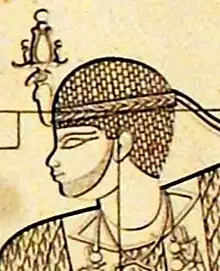Tarekeniwal
Tarekeniwal was a Kushite King of Meroë of whom little is known. He likely reigned in the second half of the 2nd century AD.[1] Tarekeniwal is only known from his pyramid in Meroe (Beg. N 19).[2] His name appears on the pylon of the cult chapel in front of the pyramid, which was in modern times restored. The chapel and its decoration is still well preserved.
| Tarekeniwal | |
|---|---|
| Kushite King of Meroe | |
 Portrait of Tarekeniwal from his tomb | |
| Reign | Second half of the 2nd century AD |
| Predecessor | Amanikhatashan |
| Successor | Amanikhalika |
| Burial | Meroe: Beg. N 19 |
| Spouse | Amanikhalika |
| Issue | Aritenyesbokhe |
Imagery in Tarekeniwal's tomb places unusually strong emphasis on him as a triumphant warrior.[3] The offering table of the later king Aritenyesbokhe identifies Aritenyesbokhe ruler as a son of Tarekeniwal, presumably the same person as the king. The table also identifies Amanikhalika as Aritenyesbokhe's mother and thus as Tarekeniwal's queen.[3]
 Pyramid of Tarekeniwal (middle)
Pyramid of Tarekeniwal (middle) Pyramid of Tarekeniwal (front)
Pyramid of Tarekeniwal (front)
References
- Kuckertz, Josefine (2021). "Meroe and Egypt". UCLA Encyclopedia of Egyptology: 6.
- Derek A. Welsby, The Kingdom of Kush (Princeton: Markus Wiener Publishers, 1998),
- Eide, Tormod; Hägg, Tomas; Holton Pierce, Richard; Török, László (1998). Fontes Historiae Nubiorum: Textual Sources for the History of the Middle Nile Region Between the Eighth Century BC and the Sixth Century AD: Vol. III: From the First to the Sixth Century AD. University of Bergen. pp. 936, 939. ISBN 82-91626-07-3.
Literature
- Inge Hofmann, Beiträge zur meroitischen Chronologie, St. Augustin bei Bonn 1978, p. 140, ISBN 3-921389-80-1
- László Török, in: Fontes Historiae Nubiorum, Vol. III, Bergen 1998, p. 935–936, ISBN 82-91626-07-3
This article is issued from Wikipedia. The text is licensed under Creative Commons - Attribution - Sharealike. Additional terms may apply for the media files.